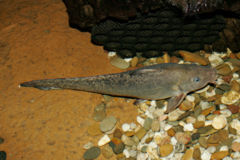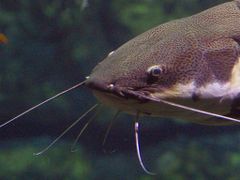|
'Catfish' |

Eel-tail catfish
|
|
Scientific classification |
|
|
| Families |
Akysidae
Amblycipitidae
Amphiliidae
Ariidae
Aspredinidae
Astroblepidae
Auchenipteridae
Bagridae
Callichthyidae
Cetopsidae
Chacidae
Clariidae
Claroteidae
Cranoglanididae
Diplomystidae
Doradidae
Erethistidae
Hypophthalmidae
Ictaluridae
Lacantuniidae
Loricariidae
Malapteruridae
Mochokidae
Nematogenyidae
Pangasiidae
Parakysidae
Pimelodidae
Plotosidae
Pseudopimelodidae
Schilbeidae
Scoloplacidae
Siluridae
Sisoridae
Trichomycteridae |
Catfish (order
Siluriformes) are a diverse group of
fish. Named for their prominent
barbels, which give the image of cat-like whiskers, they are
found primarily in freshwater environments of all kinds,
with species on every continent except Antarctica. Some
species from the families Ariidae and Plotosidae are also
found in marine environments. They feature some of the
smallest known vertebrates, including the candiru, the only
vertebrate parasite to attack humans, as well as
Pangasianodon gigas, the largest reported freshwater
fish. There are armour-plated types and also naked types,
but they do not have scales. Not all catfish families have
prominent barbels; what defines a fish as being in the order
Siluriformes are certain features of the skull and
swimbladder.
Physical characteristics
Catfish have no
scales. All catfish, except members of Malapteruridae
(electric catfish), possess a strong, hollow, bonified
leading ray on their dorsal and pectoral fins, through which
a stinging protein can be delivered if the fish is
irritated. In members of the family Plotosidae, and of the
genus Heteropneustes, this protein is so strong it may
hospitalize humans unfortunate enough to receive a sting.
Catfish, which have a sweet, mild flesh, are important as
food fish throughout the world.
Ictalurids are cultivated in North America (especially in
the Deep South, with Mississippi being the largest domestic
catfish producer)[1] while Clariids and Pangasiids are
heavily cultured in Africa and Asia. Farmed Pangasius can sometimes be found
in US supermarkets. However, the fish must be labeled as "Basa
fish" (instead of catfish) due to measures intended to
protect the American catfish farming industry.
Representatives of the genus Ictalurus have been
misguidedly introduced into European waters in the hope of
obtaining a sporting and a food resource. However, the
European stock of American catfishes has not achieved the
dimensions of these fishes in their native waters, and have
only increased the ecological pressure on native European
fauna. Clarias spp. have also been introduced in the
freshwaters of Florida, with the voracious catfish becoming
a major alien pest there.
There is a large and growing ornamental fish trade, with
hundreds of species of catfish, especially the genus
Corydoras, being a popular component of many
aquaria.

Head of the
red-tailed catfish, Phractocephalus
hemioliopterus, from the Amazon. This
species is often offered for sale when juvenile
to aquarists who little suspect it can attain
120 cm.
Size
Catfish range in size and behavior from the heaviest, the
giant Mekong catfish in Southeast Asia and the longest, the
wels catfish of Eurasia, to detritivores (species that eat
dead material on the bottom), and even to a tiny parasitic
species commonly called the candiru, Vandellia cirrhosa.
The
wels catfish, Silurus glanis, is the only native catfish
species of Europe, besides the much smaller related
Aristotle catfish found in Greece. Mythology and literature
record wels catfish of astounding proportions, yet to be
scientifically proved. The average size of the species is
about 1.2 m to 1.6 m, and fish more than 2 m are very rare.
The largest specimens on record measure more than 2.5 m in
length and sometimes exeeded 100 kg. The wels catfish was
introduced to Britain, Italy, Spain, Greece and some other
countries during the last century. The species has
flourished in the warm lakes and rivers of Southern Europe.
The River Danube, River Po in Italy and the River Ebro in Spain are famous for huge wels catfish,
which grow up to 2 m. These habitats contain plenty of food
and lack natural predators.
A very large wels catfish was caught by Kevin Maddocks on
August 6, 1999, recorded at 91.62 kg (202 lb). Tim Pruitt of
Illinois caught the largest blue catfish, Ictalurus furcatus,
in the Mississippi River on May 22, 2005 that weighed 56.25
kg (124 lb). The largest flathead catfish, Pylodictis
olivaris, ever caught was in Independence, Kansas, weighing
56 kg (123 lb 9 oz). However, these records pale in
comparison to a giant Mekong catfish caught in northern
Thailand in May 1, 2005 and reported to the press almost 2 months later,
that weighed 293 kg (646 lb). This is the largest giant
Mekong catfish caught, but only since Thai officials started
keeping records in 1981
[2]. The giant
Mekong catfish are not well studied since they live in
developing countries and it is quite possible that they can
grow even larger.
Family
Catfish belong to a superorder called the Ostariophysi,
which also includes the Cypriniformes, Characiformes,
Gonorynchiformes and Gymnotiformes (although some place
Gymnotiformes as a sub-order of Siluriformes). As of 2005
there are 37 catfish families, and around 2,000 species have
been described, although this number is in constant flux due
to taxonomic work on the order.
In June, 2005, researchers named the 37th family of
catfish, Lacantuniidae, only the third new family of fish
distinguished in the last 70 years (others being the
coelacanth in 1938 and the megamouth shark in 1983). The new
species in Lacantuniidae, Lacantunia enigmatica, was found
in the Lacantun river in Chiapas, Mexico.
Southern tradition
In the southeast of the United States, catfish is an
extremely popular food. The fish, mostly channel catfish and
blue catfish, are found in most waterways in the region. The
fish is typically breaded with cornmeal and fried. Catfish are easy to farm in warm
climates, leading to inexpensive and safe food in local
grocers. This has further increased its popularity in the
U.S. as food.
A popular sport among some in these areas is
noodling, which involves catching catfish using only
one's bare hands by luring a catfish to bite the noodler's
hand and then grabbing the fish's
gills.
Trivia
- In the United States,
June 25 is National Catfish Day.
Other catfish
- Iridescent Shark
Channel catfish
Redtail catfish

Market-size USDA 103 catfish ready for harvest.
This new variety grows faster than other
catfish.
References
- ^
J.E. Morris (October 1993). "Pond
Culture of Channel Catfish in the North Central Region".
North Central Regional Aquaculture Center. Retrieved on
2006-06-28.
-
^
Grizzly Bear-Size Catfish Caught in Thailand.
National Geographic News. Retrieved on
2006-07-14.




